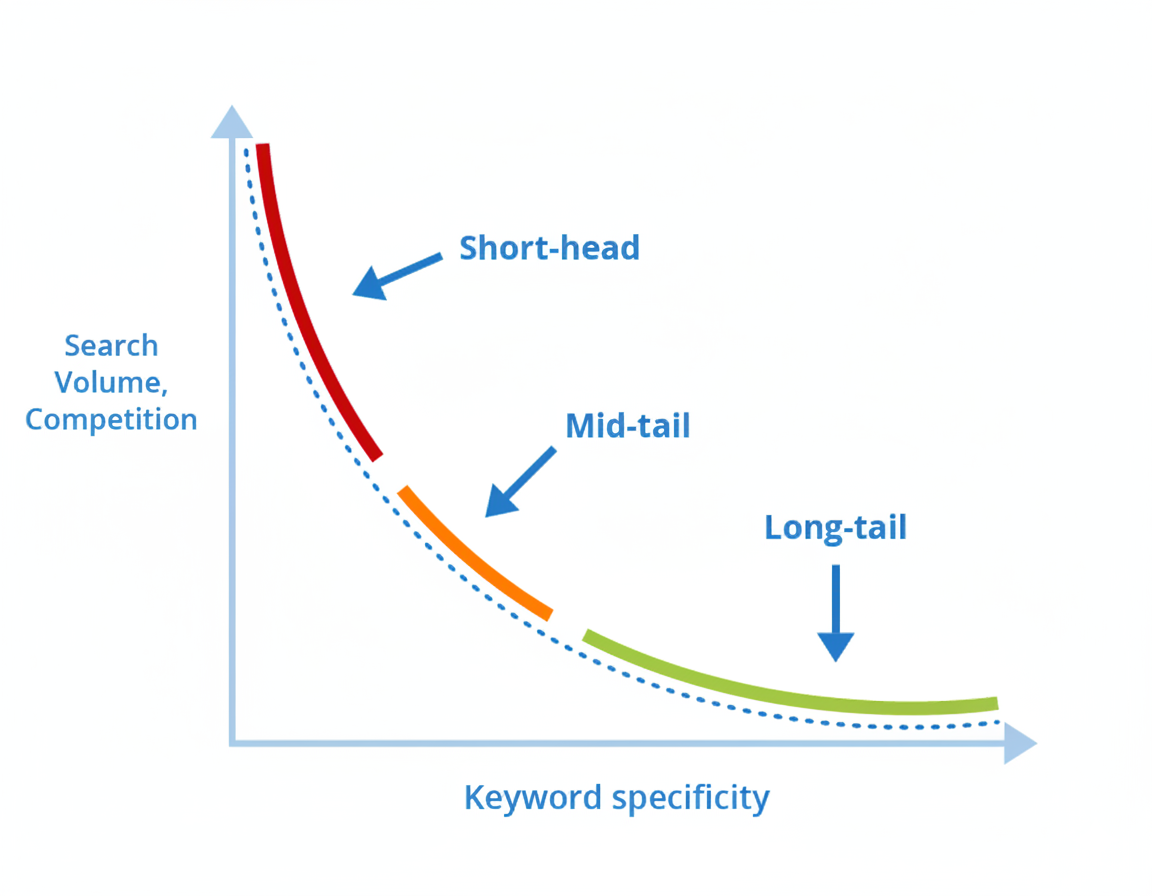Longtail keywords are the longer, more specific search phrases that people type into search engines. Unlike short, generic keywords (called "head terms"), longtail keywords typically contain three or more words and target a specific search intent.
Definition
A longtail keyword is a search query that is:
- Longer (typically 3+ words)
- More specific (targets a particular need or question)
- Less competitive (easier to rank for)
- More targeted (attracts qualified traffic)
Examples of Longtail Keywords
Let's compare short-tail vs longtail keywords:
| Short-tail Keyword | Longtail Keyword |
|---|---|
| "running shoes" | "best running shoes for flat feet women" |
| "coffee maker" | "how to clean a Keurig coffee maker" |
| "SEO" | "what is local SEO for small businesses" |
| "laptop" | "affordable gaming laptop under $1000" |
As you can see, longtail keywords are much more specific and reveal clear intent about what the searcher wants.
Why They're Called "Longtail"
The term comes from the "long tail" of the search demand curve:
- Head terms (1-2 words): High search volume, high competition
- Middle tail (2-3 words): Medium search volume, medium competition
- Longtail (3+ words): Low individual volume, but collectively represent 70% of all searches

Key Characteristics
1. Lower Search Volume
A longtail keyword like "best running shoes for flat feet women" might only get 500 searches per month, compared to "running shoes" which gets 100,000+.
2. Higher Conversion Rate
Because longtail keywords are specific, searchers using them are usually further along in their buyer journey. Someone searching "buy Nike Air Zoom Pegasus 40 size 9" is ready to purchase!
3. Less Competition
Fewer websites target specific longtail phrases, making them easier to rank for — even for new or small websites.
4. Clear Intent
Longtail keywords reveal exactly what the user wants:
- "how to train for a marathon" → Looking for information
- "best marathon training app" → Comparing options
- "buy Garmin Forerunner 265" → Ready to buy
Types of Longtail Keywords
Question-Based
- "how do longtail keywords work"
- "why are my running shoes wearing unevenly"
- "when to replace running shoes"
Location-Based
- "best SEO agency in Austin Texas"
- "running shoe store near me"
- "organic coffee shop downtown Seattle"
Product-Specific
- "Samsung Galaxy S24 Ultra vs iPhone 15 Pro Max"
- "Brooks Ghost 15 review for overpronation"
- "affordable standing desk with electric motor"
Problem-Solution
- "fix squeaky running shoes"
- "reduce bounce rate on blog posts"
- "remove coffee stains from white shirt"
Ready to Find Your Longtail Keywords?
Now that you understand what longtail keywords are, discover thousands of them for your specific niche with our free keyword research tool
Why Longtail Keywords Matter
Here's why you should care about longtail keywords:
- Easier to rank - Less competition means better chances of reaching page 1
- Better ROI - Higher conversion rates mean more value per visitor
- Voice search optimization - People speak in longtail phrases: "Hey Google, where's the best pizza near me?"
- Content ideas - Each longtail keyword is a potential blog post or page
- Targeted traffic - Attract visitors who are looking for exactly what you offer
Quick Example
Let's say you sell running shoes online:
Bad strategy: Target "running shoes" (impossible to rank, generic traffic)
Good strategy: Target multiple longtail keywords like:
- "best running shoes for plantar fasciitis"
- "lightweight running shoes for marathon training"
- "affordable trail running shoes under $100"
- "running shoes for wide feet men"
Each of these brings qualified traffic that's more likely to convert!
Summary
Longtail keywords are longer, more specific search phrases that:
- Have lower search volume individually
- Attract highly targeted traffic
- Are easier to rank for
- Convert better than generic keywords
- Represent the majority of all Google searches
In the next guide, we'll explore why longtail keywords are crucial for your SEO strategy and dive into the data that proves their effectiveness.